Strategic Finance Overview: Tesco PLC Financial Performance Report
VerifiedAdded on 2022/12/26
|15
|3705
|1
Report
AI Summary
This report provides a strategic finance overview of Tesco PLC's financial performance, focusing on the years 2018 and 2019. It begins with an introduction to strategic financial management, emphasizing the importance of financial statement analysis. The report then delves into the calculation of various financial ratios, including current ratio, quick ratio, gross profit ratio, return on equity, non-current assets turnover, gearing ratio, dividend ratio, interest ratio, return on capital employed, and operating profit ratio. These ratios are used to evaluate Tesco's liquidity, profitability, and efficiency. The analysis reveals a decline in Tesco's financial performance compared to 2018, attributed to issues in asset and inventory management, cost control, and pricing strategies. The report concludes with recommendations for improvement, including benchmarking, financial governance, planning, performance measurement, and employee training programs. These strategies aim to enhance sales, manage debt, and improve overall financial health.

STRATEGIC FINANCE OVERVIEW
Paraphrase This Document
Need a fresh take? Get an instant paraphrase of this document with our AI Paraphraser
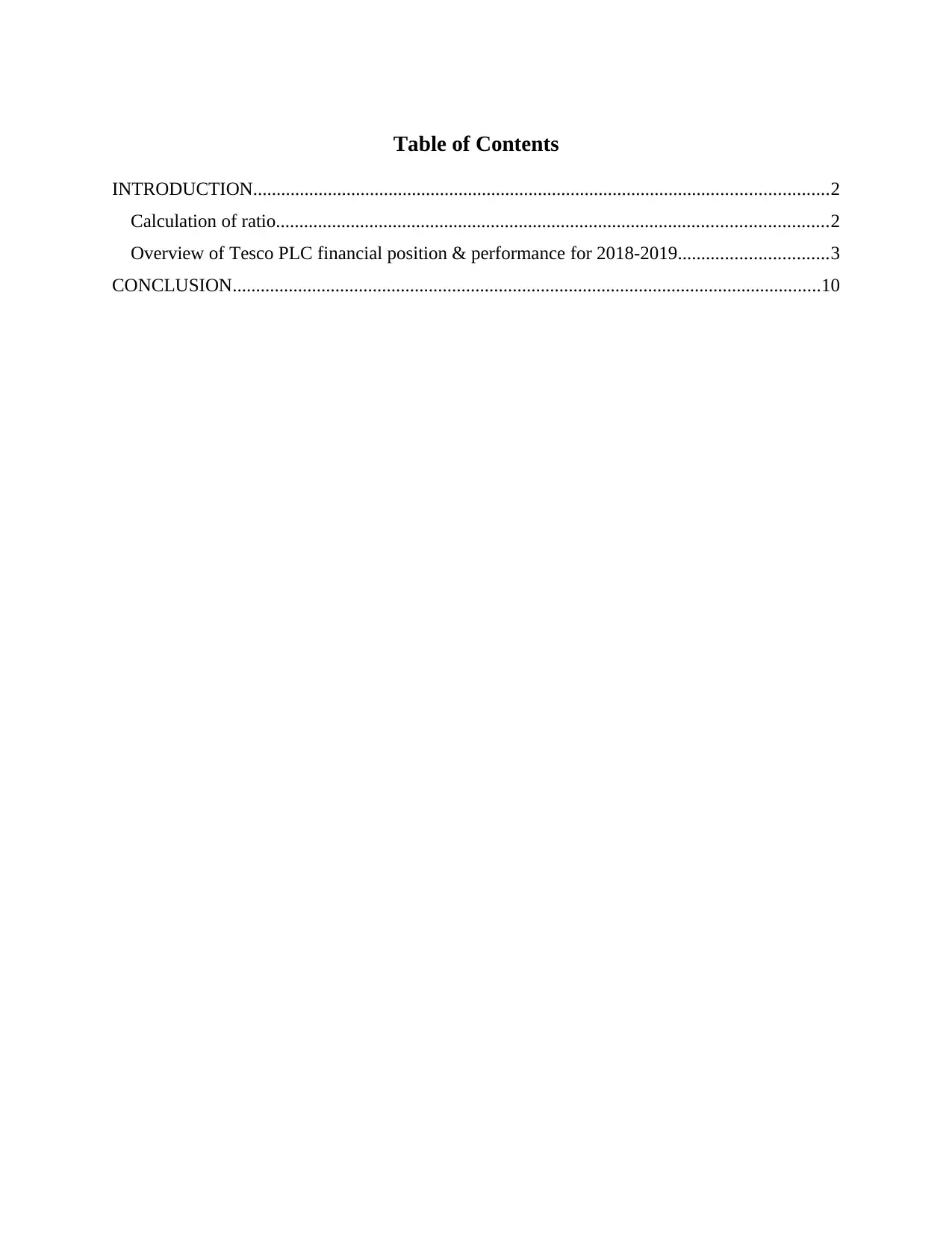
Table of Contents
INTRODUCTION...........................................................................................................................2
Calculation of ratio......................................................................................................................2
Overview of Tesco PLC financial position & performance for 2018-2019................................3
CONCLUSION..............................................................................................................................10
INTRODUCTION...........................................................................................................................2
Calculation of ratio......................................................................................................................2
Overview of Tesco PLC financial position & performance for 2018-2019................................3
CONCLUSION..............................................................................................................................10
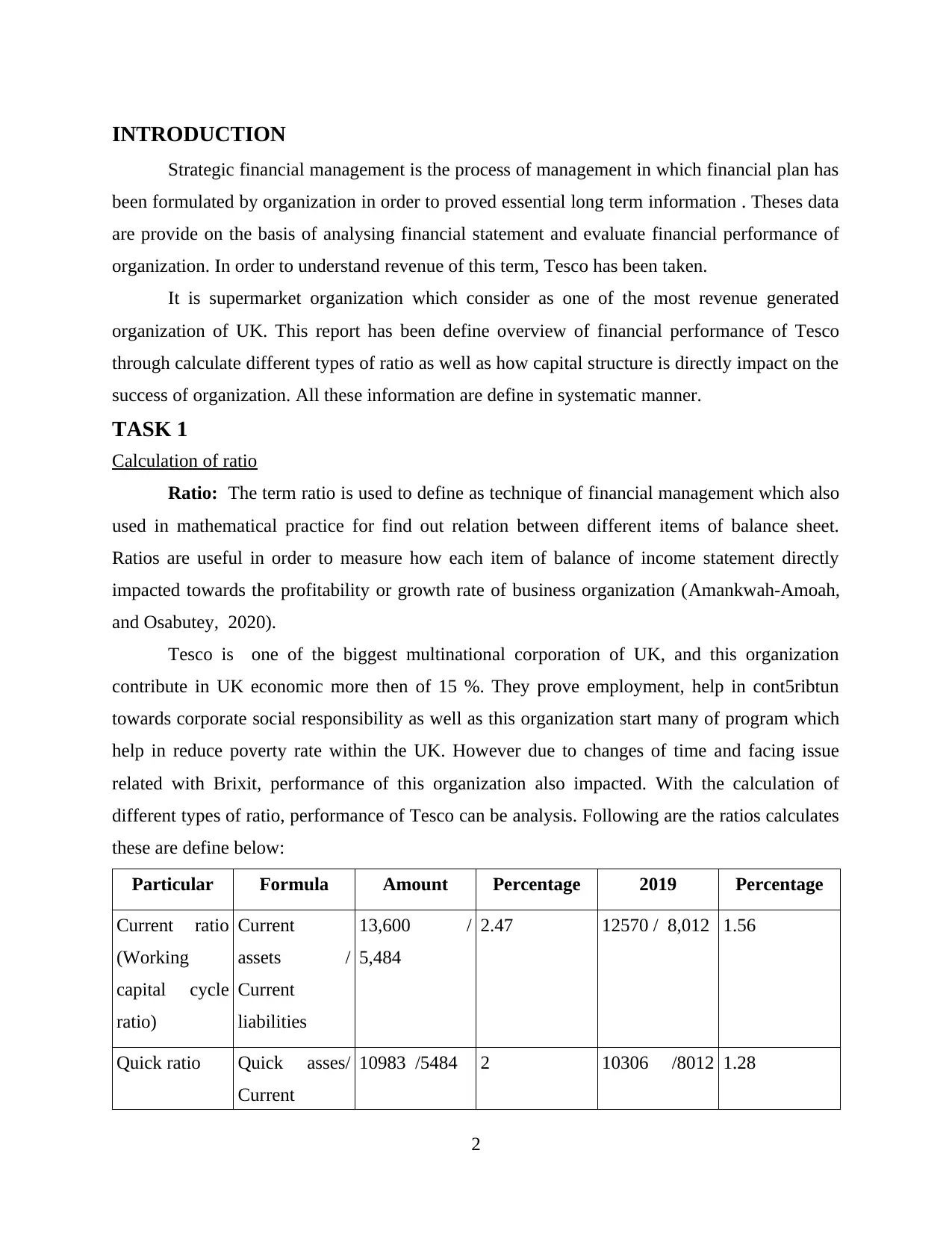
INTRODUCTION
Strategic financial management is the process of management in which financial plan has
been formulated by organization in order to proved essential long term information . Theses data
are provide on the basis of analysing financial statement and evaluate financial performance of
organization. In order to understand revenue of this term, Tesco has been taken.
It is supermarket organization which consider as one of the most revenue generated
organization of UK. This report has been define overview of financial performance of Tesco
through calculate different types of ratio as well as how capital structure is directly impact on the
success of organization. All these information are define in systematic manner.
TASK 1
Calculation of ratio
Ratio: The term ratio is used to define as technique of financial management which also
used in mathematical practice for find out relation between different items of balance sheet.
Ratios are useful in order to measure how each item of balance of income statement directly
impacted towards the profitability or growth rate of business organization (Amankwah-Amoah,
and Osabutey, 2020).
Tesco is one of the biggest multinational corporation of UK, and this organization
contribute in UK economic more then of 15 %. They prove employment, help in cont5ribtun
towards corporate social responsibility as well as this organization start many of program which
help in reduce poverty rate within the UK. However due to changes of time and facing issue
related with Brixit, performance of this organization also impacted. With the calculation of
different types of ratio, performance of Tesco can be analysis. Following are the ratios calculates
these are define below:
Particular Formula Amount Percentage 2019 Percentage
Current ratio
(Working
capital cycle
ratio)
Current
assets /
Current
liabilities
13,600 /
5,484
2.47 12570 / 8,012 1.56
Quick ratio Quick asses/
Current
10983 /5484 2 10306 /8012 1.28
2
Strategic financial management is the process of management in which financial plan has
been formulated by organization in order to proved essential long term information . Theses data
are provide on the basis of analysing financial statement and evaluate financial performance of
organization. In order to understand revenue of this term, Tesco has been taken.
It is supermarket organization which consider as one of the most revenue generated
organization of UK. This report has been define overview of financial performance of Tesco
through calculate different types of ratio as well as how capital structure is directly impact on the
success of organization. All these information are define in systematic manner.
TASK 1
Calculation of ratio
Ratio: The term ratio is used to define as technique of financial management which also
used in mathematical practice for find out relation between different items of balance sheet.
Ratios are useful in order to measure how each item of balance of income statement directly
impacted towards the profitability or growth rate of business organization (Amankwah-Amoah,
and Osabutey, 2020).
Tesco is one of the biggest multinational corporation of UK, and this organization
contribute in UK economic more then of 15 %. They prove employment, help in cont5ribtun
towards corporate social responsibility as well as this organization start many of program which
help in reduce poverty rate within the UK. However due to changes of time and facing issue
related with Brixit, performance of this organization also impacted. With the calculation of
different types of ratio, performance of Tesco can be analysis. Following are the ratios calculates
these are define below:
Particular Formula Amount Percentage 2019 Percentage
Current ratio
(Working
capital cycle
ratio)
Current
assets /
Current
liabilities
13,600 /
5,484
2.47 12570 / 8,012 1.56
Quick ratio Quick asses/
Current
10983 /5484 2 10306 /8012 1.28
2
⊘ This is a preview!⊘
Do you want full access?
Subscribe today to unlock all pages.

Trusted by 1+ million students worldwide
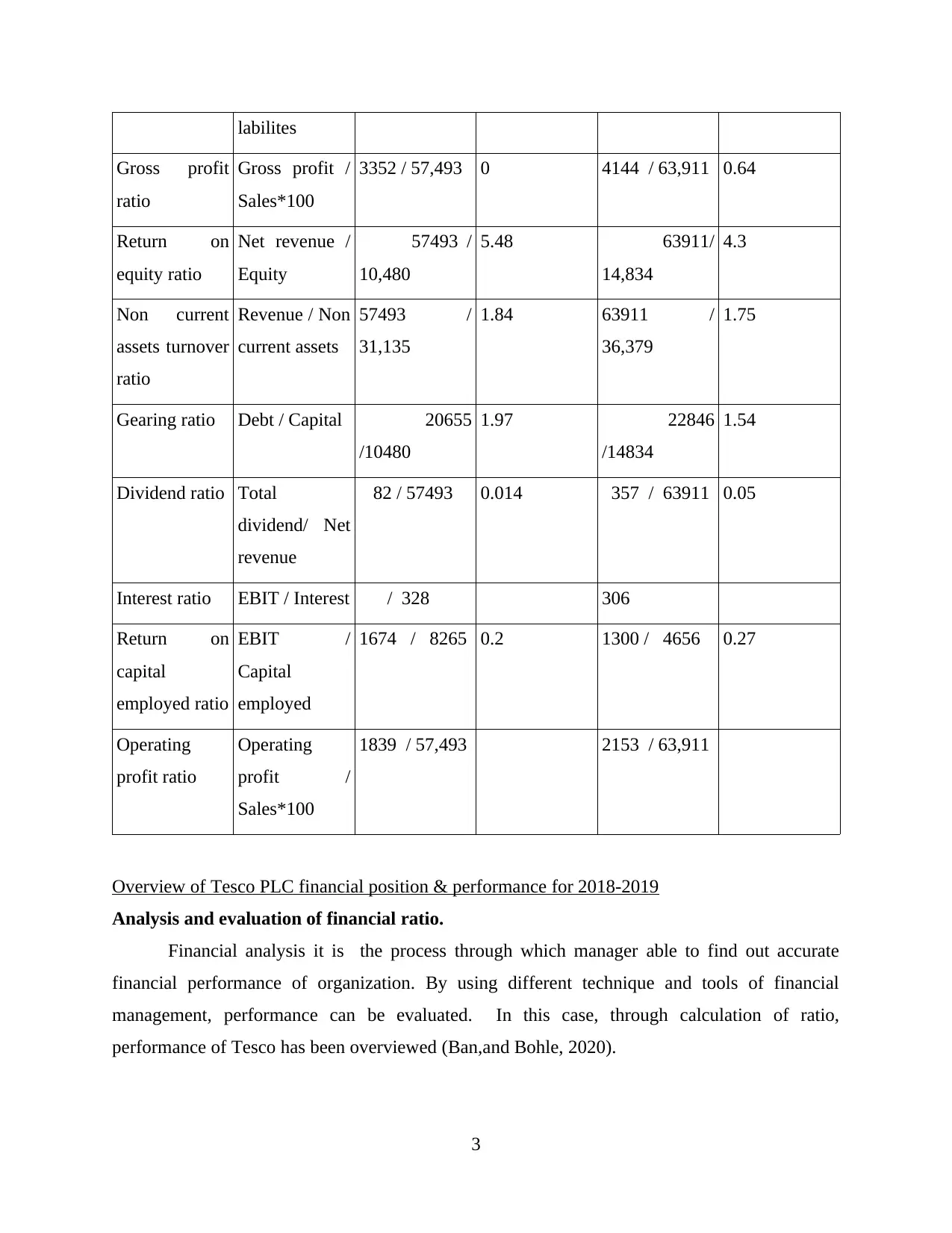
labilites
Gross profit
ratio
Gross profit /
Sales*100
3352 / 57,493 0 4144 / 63,911 0.64
Return on
equity ratio
Net revenue /
Equity
57493 /
10,480
5.48 63911/
14,834
4.3
Non current
assets turnover
ratio
Revenue / Non
current assets
57493 /
31,135
1.84 63911 /
36,379
1.75
Gearing ratio Debt / Capital 20655
/10480
1.97 22846
/14834
1.54
Dividend ratio Total
dividend/ Net
revenue
82 / 57493 0.014 357 / 63911 0.05
Interest ratio EBIT / Interest / 328 306
Return on
capital
employed ratio
EBIT /
Capital
employed
1674 / 8265 0.2 1300 / 4656 0.27
Operating
profit ratio
Operating
profit /
Sales*100
1839 / 57,493 2153 / 63,911
Overview of Tesco PLC financial position & performance for 2018-2019
Analysis and evaluation of financial ratio.
Financial analysis it is the process through which manager able to find out accurate
financial performance of organization. By using different technique and tools of financial
management, performance can be evaluated. In this case, through calculation of ratio,
performance of Tesco has been overviewed (Ban,and Bohle, 2020).
3
Gross profit
ratio
Gross profit /
Sales*100
3352 / 57,493 0 4144 / 63,911 0.64
Return on
equity ratio
Net revenue /
Equity
57493 /
10,480
5.48 63911/
14,834
4.3
Non current
assets turnover
ratio
Revenue / Non
current assets
57493 /
31,135
1.84 63911 /
36,379
1.75
Gearing ratio Debt / Capital 20655
/10480
1.97 22846
/14834
1.54
Dividend ratio Total
dividend/ Net
revenue
82 / 57493 0.014 357 / 63911 0.05
Interest ratio EBIT / Interest / 328 306
Return on
capital
employed ratio
EBIT /
Capital
employed
1674 / 8265 0.2 1300 / 4656 0.27
Operating
profit ratio
Operating
profit /
Sales*100
1839 / 57,493 2153 / 63,911
Overview of Tesco PLC financial position & performance for 2018-2019
Analysis and evaluation of financial ratio.
Financial analysis it is the process through which manager able to find out accurate
financial performance of organization. By using different technique and tools of financial
management, performance can be evaluated. In this case, through calculation of ratio,
performance of Tesco has been overviewed (Ban,and Bohle, 2020).
3
Paraphrase This Document
Need a fresh take? Get an instant paraphrase of this document with our AI Paraphraser

Current ratio (Working capital cycle ratio): This ratio measure relationship between
current assets and current liabilities. On the basis of calculating values manager able to
recognize ability of organization to pay their short term business liabilities. These are
useful in order to measure cash flow activities within the organization. Higher current
ratio showcase organization have sufficient capital to pay their debt and vice versa. In
case of Tesco organization's current ratio was valued in 2018 was 2.47 and on the other
side in 2019 it was 1.56, which define that as compare with 2018 Tesco's performance
related with liquidity has been decline.
The main reason of decline rate is that organization not able to effectively manage their current
asst and their expenses related with management of inventory has been increase thus current ratio
has been decline (Zhou, 2020).
Quick ratio: This is also consider as the part of liquidity ratio. With the calculation of
this ratio manager able to find out how much cash or cash equivalent assets organization
have in order to full-fill their debt liabilities. With the measurement of this ratio, manager
define ability of cope up with situation. On the basis of evaluating business performance
manager able to decide and formulate business policies which are help in attaining long
term goals of business was organization.
4
2.47
1.56
Current ratio
current assets and current liabilities. On the basis of calculating values manager able to
recognize ability of organization to pay their short term business liabilities. These are
useful in order to measure cash flow activities within the organization. Higher current
ratio showcase organization have sufficient capital to pay their debt and vice versa. In
case of Tesco organization's current ratio was valued in 2018 was 2.47 and on the other
side in 2019 it was 1.56, which define that as compare with 2018 Tesco's performance
related with liquidity has been decline.
The main reason of decline rate is that organization not able to effectively manage their current
asst and their expenses related with management of inventory has been increase thus current ratio
has been decline (Zhou, 2020).
Quick ratio: This is also consider as the part of liquidity ratio. With the calculation of
this ratio manager able to find out how much cash or cash equivalent assets organization
have in order to full-fill their debt liabilities. With the measurement of this ratio, manager
define ability of cope up with situation. On the basis of evaluating business performance
manager able to decide and formulate business policies which are help in attaining long
term goals of business was organization.
4
2.47
1.56
Current ratio
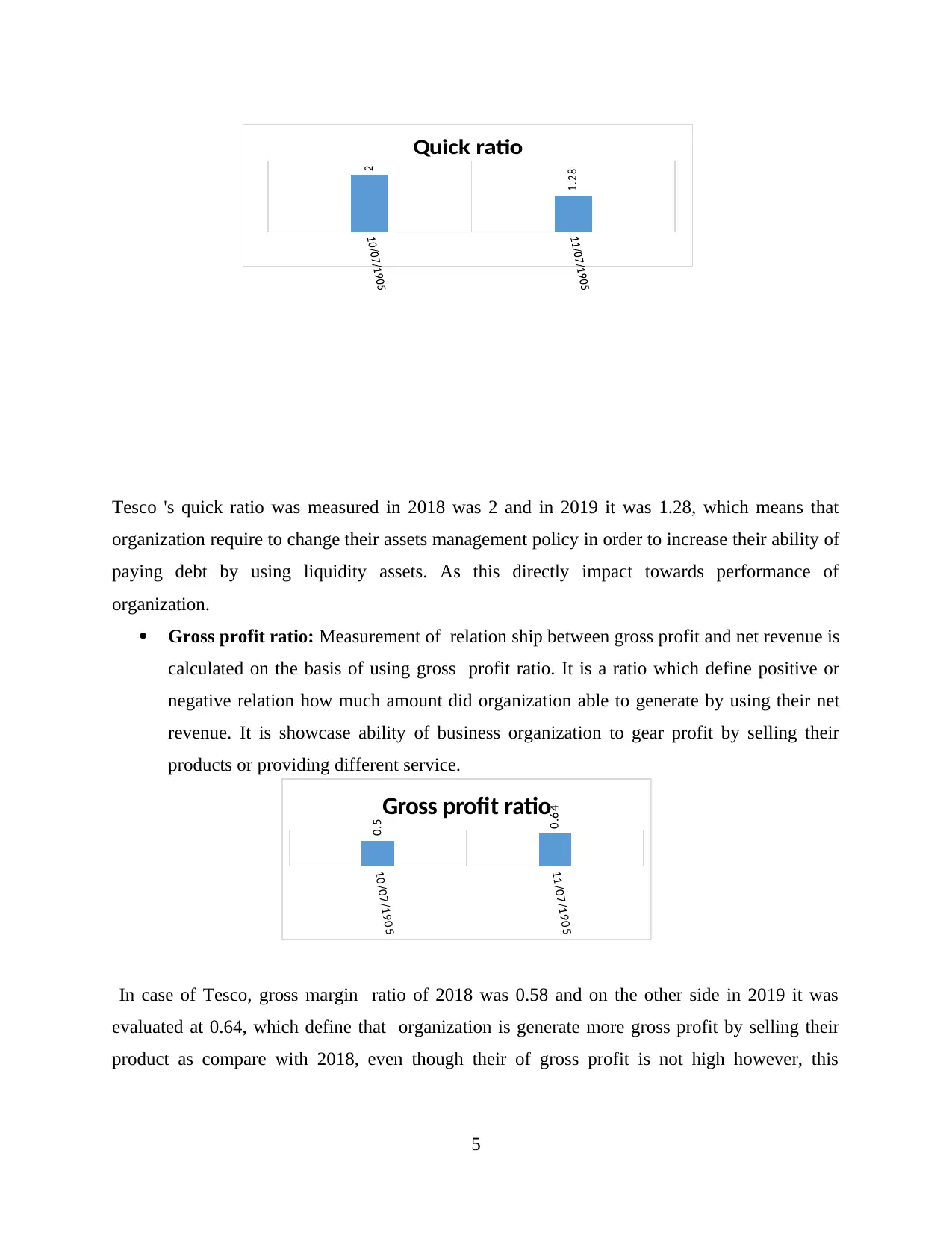
Tesco 's quick ratio was measured in 2018 was 2 and in 2019 it was 1.28, which means that
organization require to change their assets management policy in order to increase their ability of
paying debt by using liquidity assets. As this directly impact towards performance of
organization.
Gross profit ratio: Measurement of relation ship between gross profit and net revenue is
calculated on the basis of using gross profit ratio. It is a ratio which define positive or
negative relation how much amount did organization able to generate by using their net
revenue. It is showcase ability of business organization to gear profit by selling their
products or providing different service.
In case of Tesco, gross margin ratio of 2018 was 0.58 and on the other side in 2019 it was
evaluated at 0.64, which define that organization is generate more gross profit by selling their
product as compare with 2018, even though their of gross profit is not high however, this
5
2
1 .2 8
Quick ratio
10/07/1905
11/07/1905
0.5
0.64
Gross profit ratio
organization require to change their assets management policy in order to increase their ability of
paying debt by using liquidity assets. As this directly impact towards performance of
organization.
Gross profit ratio: Measurement of relation ship between gross profit and net revenue is
calculated on the basis of using gross profit ratio. It is a ratio which define positive or
negative relation how much amount did organization able to generate by using their net
revenue. It is showcase ability of business organization to gear profit by selling their
products or providing different service.
In case of Tesco, gross margin ratio of 2018 was 0.58 and on the other side in 2019 it was
evaluated at 0.64, which define that organization is generate more gross profit by selling their
product as compare with 2018, even though their of gross profit is not high however, this
5
2
1 .2 8
Quick ratio
10/07/1905
11/07/1905
0.5
0.64
Gross profit ratio
⊘ This is a preview!⊘
Do you want full access?
Subscribe today to unlock all pages.

Trusted by 1+ million students worldwide
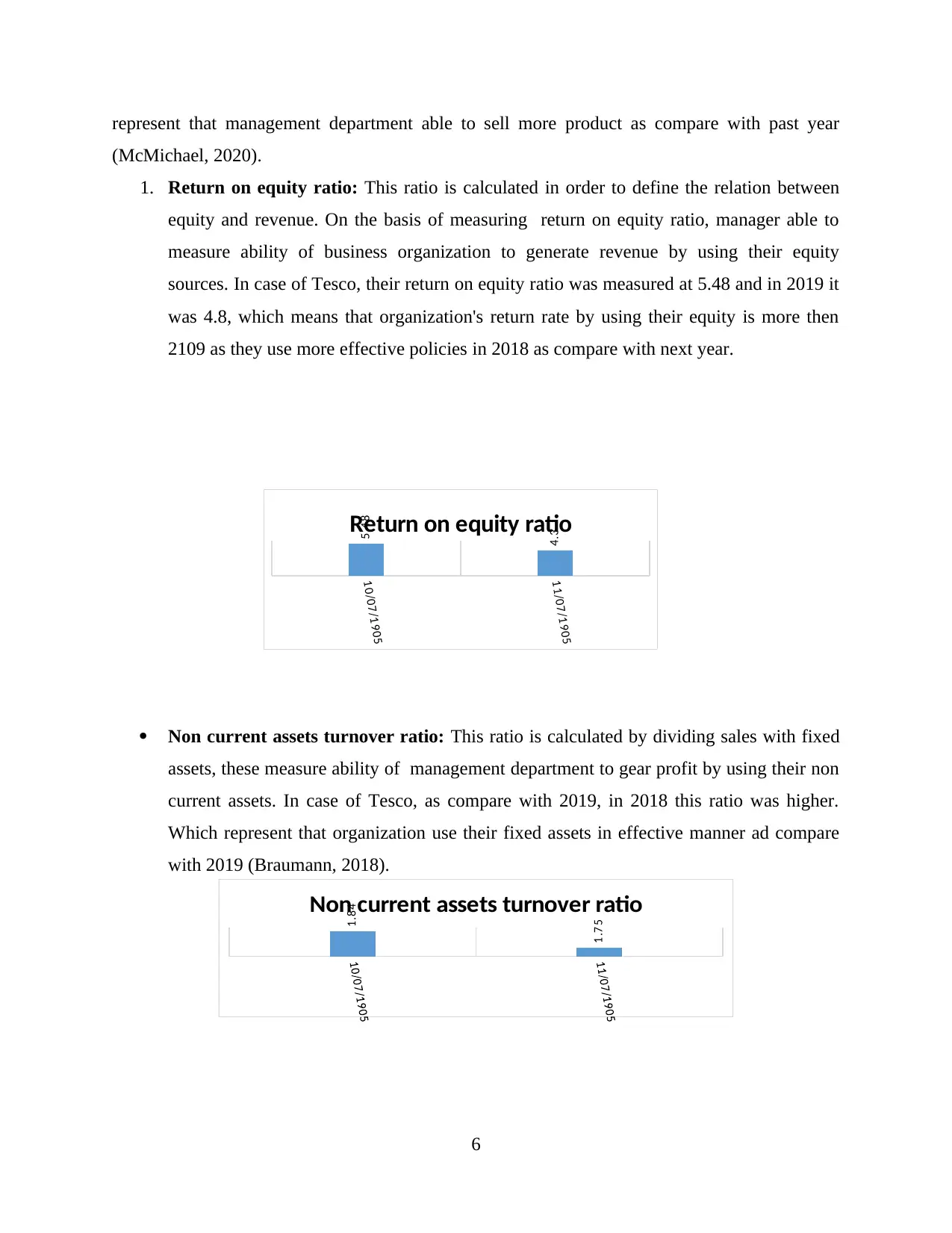
represent that management department able to sell more product as compare with past year
(McMichael, 2020).
1. Return on equity ratio: This ratio is calculated in order to define the relation between
equity and revenue. On the basis of measuring return on equity ratio, manager able to
measure ability of business organization to generate revenue by using their equity
sources. In case of Tesco, their return on equity ratio was measured at 5.48 and in 2019 it
was 4.8, which means that organization's return rate by using their equity is more then
2109 as they use more effective policies in 2018 as compare with next year.
Non current assets turnover ratio: This ratio is calculated by dividing sales with fixed
assets, these measure ability of management department to gear profit by using their non
current assets. In case of Tesco, as compare with 2019, in 2018 this ratio was higher.
Which represent that organization use their fixed assets in effective manner ad compare
with 2019 (Braumann, 2018).
6
10/07/1905
11/07/1905
5.48
4.3Return on equity ratio
1.84
1.75
Non current assets turnover ratio
(McMichael, 2020).
1. Return on equity ratio: This ratio is calculated in order to define the relation between
equity and revenue. On the basis of measuring return on equity ratio, manager able to
measure ability of business organization to generate revenue by using their equity
sources. In case of Tesco, their return on equity ratio was measured at 5.48 and in 2019 it
was 4.8, which means that organization's return rate by using their equity is more then
2109 as they use more effective policies in 2018 as compare with next year.
Non current assets turnover ratio: This ratio is calculated by dividing sales with fixed
assets, these measure ability of management department to gear profit by using their non
current assets. In case of Tesco, as compare with 2019, in 2018 this ratio was higher.
Which represent that organization use their fixed assets in effective manner ad compare
with 2019 (Braumann, 2018).
6
10/07/1905
11/07/1905
5.48
4.3Return on equity ratio
1.84
1.75
Non current assets turnover ratio
Paraphrase This Document
Need a fresh take? Get an instant paraphrase of this document with our AI Paraphraser
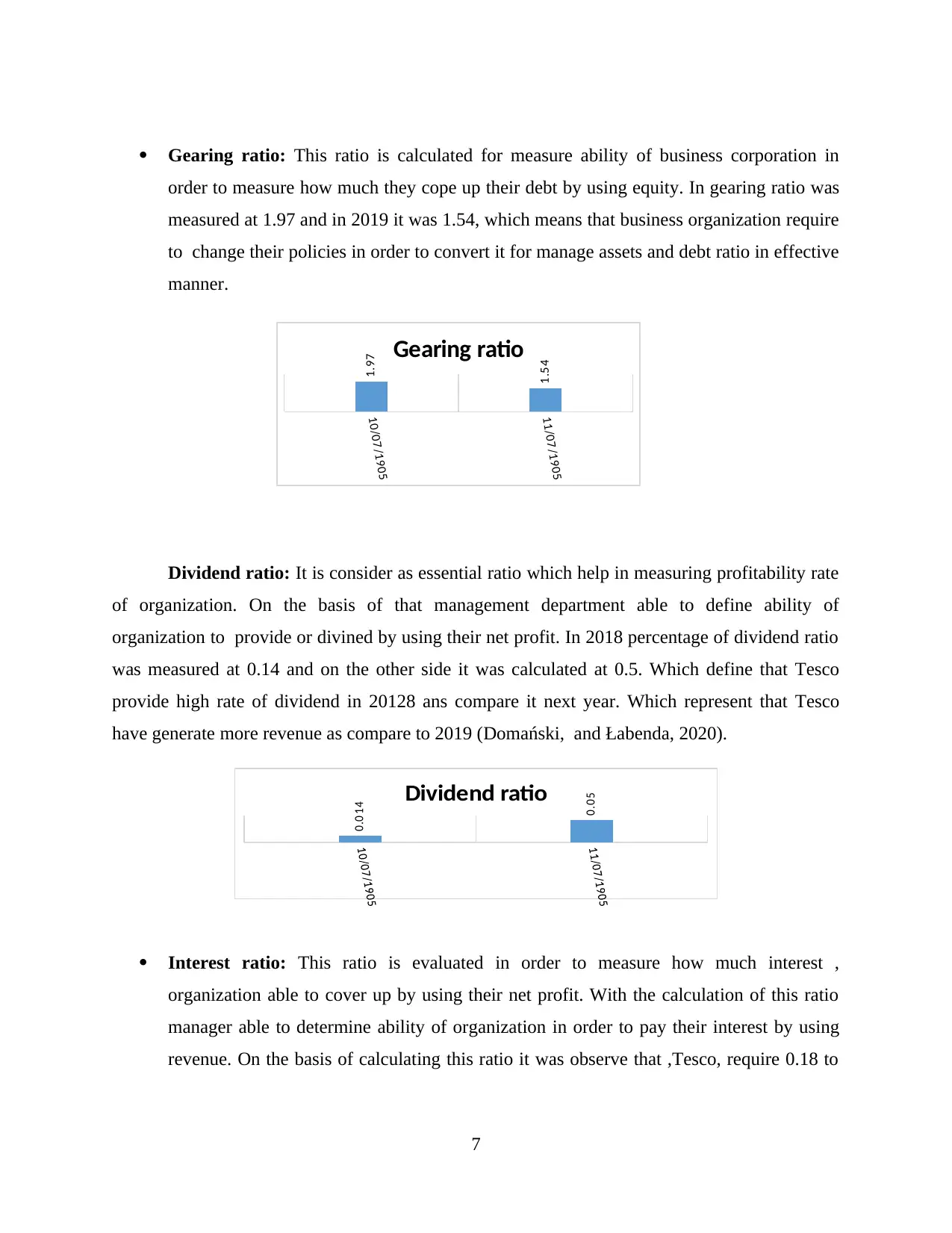
Gearing ratio: This ratio is calculated for measure ability of business corporation in
order to measure how much they cope up their debt by using equity. In gearing ratio was
measured at 1.97 and in 2019 it was 1.54, which means that business organization require
to change their policies in order to convert it for manage assets and debt ratio in effective
manner.
Dividend ratio: It is consider as essential ratio which help in measuring profitability rate
of organization. On the basis of that management department able to define ability of
organization to provide or divined by using their net profit. In 2018 percentage of dividend ratio
was measured at 0.14 and on the other side it was calculated at 0.5. Which define that Tesco
provide high rate of dividend in 20128 ans compare it next year. Which represent that Tesco
have generate more revenue as compare to 2019 (Domański, and Łabenda, 2020).
Interest ratio: This ratio is evaluated in order to measure how much interest ,
organization able to cover up by using their net profit. With the calculation of this ratio
manager able to determine ability of organization in order to pay their interest by using
revenue. On the basis of calculating this ratio it was observe that ,Tesco, require 0.18 to
7
10/07/1905
11/07/1905
1.97
1.54Gearing ratio
0 .0 1 4
0 .0 5
Dividend ratio
order to measure how much they cope up their debt by using equity. In gearing ratio was
measured at 1.97 and in 2019 it was 1.54, which means that business organization require
to change their policies in order to convert it for manage assets and debt ratio in effective
manner.
Dividend ratio: It is consider as essential ratio which help in measuring profitability rate
of organization. On the basis of that management department able to define ability of
organization to provide or divined by using their net profit. In 2018 percentage of dividend ratio
was measured at 0.14 and on the other side it was calculated at 0.5. Which define that Tesco
provide high rate of dividend in 20128 ans compare it next year. Which represent that Tesco
have generate more revenue as compare to 2019 (Domański, and Łabenda, 2020).
Interest ratio: This ratio is evaluated in order to measure how much interest ,
organization able to cover up by using their net profit. With the calculation of this ratio
manager able to determine ability of organization in order to pay their interest by using
revenue. On the basis of calculating this ratio it was observe that ,Tesco, require 0.18 to
7
10/07/1905
11/07/1905
1.97
1.54Gearing ratio
0 .0 1 4
0 .0 5
Dividend ratio
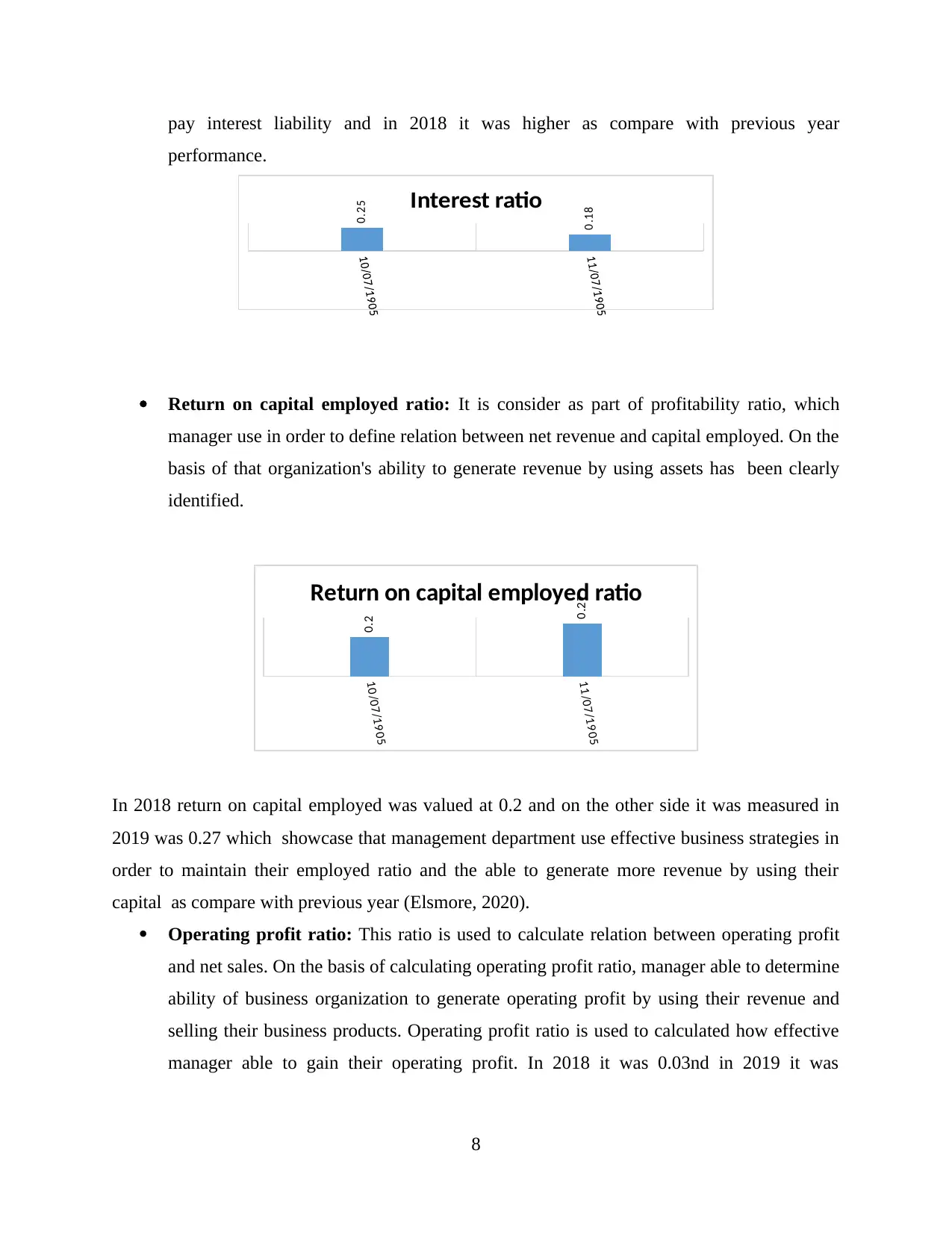
pay interest liability and in 2018 it was higher as compare with previous year
performance.
Return on capital employed ratio: It is consider as part of profitability ratio, which
manager use in order to define relation between net revenue and capital employed. On the
basis of that organization's ability to generate revenue by using assets has been clearly
identified.
In 2018 return on capital employed was valued at 0.2 and on the other side it was measured in
2019 was 0.27 which showcase that management department use effective business strategies in
order to maintain their employed ratio and the able to generate more revenue by using their
capital as compare with previous year (Elsmore, 2020).
Operating profit ratio: This ratio is used to calculate relation between operating profit
and net sales. On the basis of calculating operating profit ratio, manager able to determine
ability of business organization to generate operating profit by using their revenue and
selling their business products. Operating profit ratio is used to calculated how effective
manager able to gain their operating profit. In 2018 it was 0.03nd in 2019 it was
8
0.25
0.18Interest ratio
10/07/1905
11/07/1905
0.2
0.27Return on capital employed ratio
performance.
Return on capital employed ratio: It is consider as part of profitability ratio, which
manager use in order to define relation between net revenue and capital employed. On the
basis of that organization's ability to generate revenue by using assets has been clearly
identified.
In 2018 return on capital employed was valued at 0.2 and on the other side it was measured in
2019 was 0.27 which showcase that management department use effective business strategies in
order to maintain their employed ratio and the able to generate more revenue by using their
capital as compare with previous year (Elsmore, 2020).
Operating profit ratio: This ratio is used to calculate relation between operating profit
and net sales. On the basis of calculating operating profit ratio, manager able to determine
ability of business organization to generate operating profit by using their revenue and
selling their business products. Operating profit ratio is used to calculated how effective
manager able to gain their operating profit. In 2018 it was 0.03nd in 2019 it was
8
0.25
0.18Interest ratio
10/07/1905
11/07/1905
0.2
0.27Return on capital employed ratio
⊘ This is a preview!⊘
Do you want full access?
Subscribe today to unlock all pages.

Trusted by 1+ million students worldwide
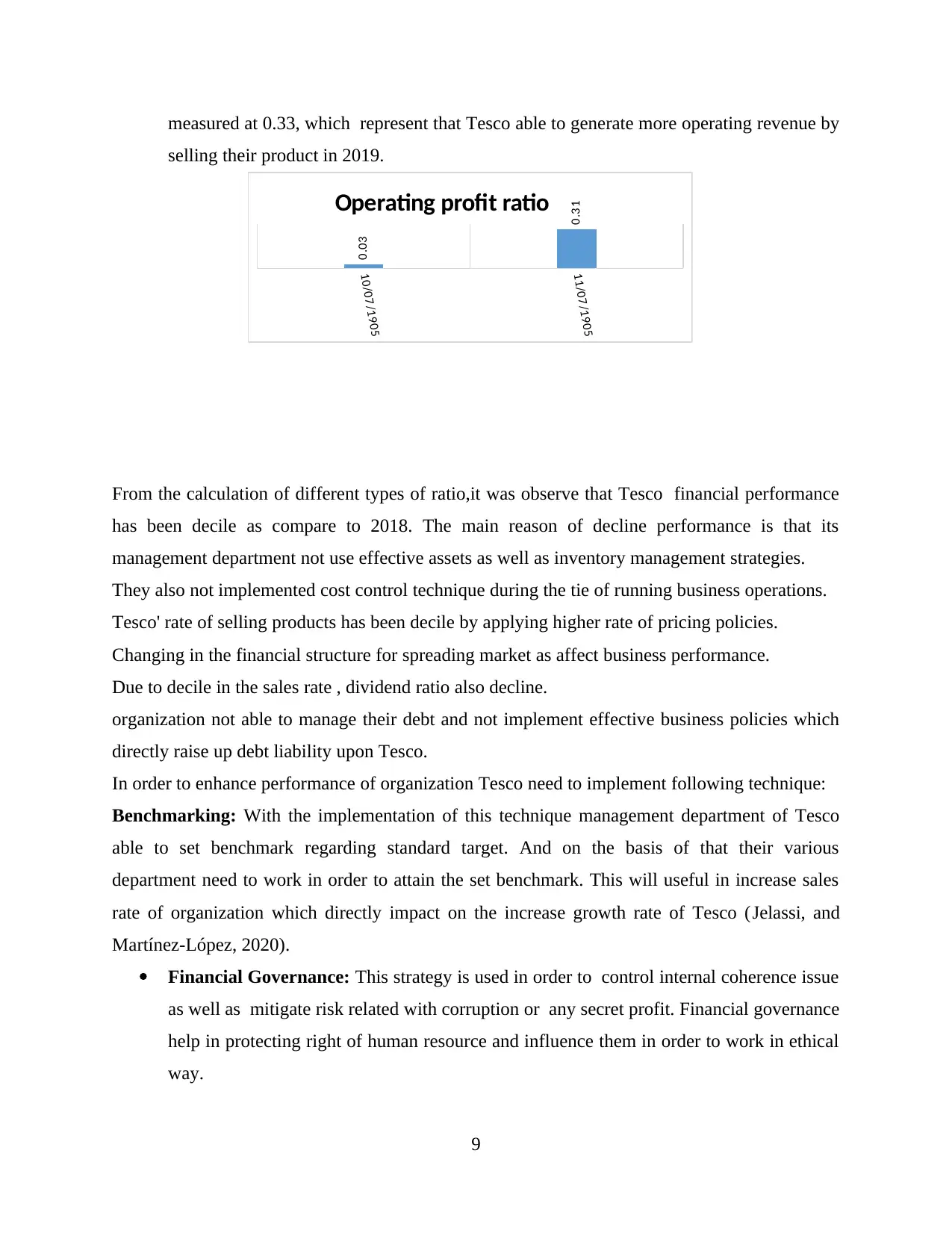
measured at 0.33, which represent that Tesco able to generate more operating revenue by
selling their product in 2019.
From the calculation of different types of ratio,it was observe that Tesco financial performance
has been decile as compare to 2018. The main reason of decline performance is that its
management department not use effective assets as well as inventory management strategies.
They also not implemented cost control technique during the tie of running business operations.
Tesco' rate of selling products has been decile by applying higher rate of pricing policies.
Changing in the financial structure for spreading market as affect business performance.
Due to decile in the sales rate , dividend ratio also decline.
organization not able to manage their debt and not implement effective business policies which
directly raise up debt liability upon Tesco.
In order to enhance performance of organization Tesco need to implement following technique:
Benchmarking: With the implementation of this technique management department of Tesco
able to set benchmark regarding standard target. And on the basis of that their various
department need to work in order to attain the set benchmark. This will useful in increase sales
rate of organization which directly impact on the increase growth rate of Tesco (Jelassi, and
Martínez-López, 2020).
Financial Governance: This strategy is used in order to control internal coherence issue
as well as mitigate risk related with corruption or any secret profit. Financial governance
help in protecting right of human resource and influence them in order to work in ethical
way.
9
10/07/1905
11/07/1905
0.03
0.31
Operating profit ratio
selling their product in 2019.
From the calculation of different types of ratio,it was observe that Tesco financial performance
has been decile as compare to 2018. The main reason of decline performance is that its
management department not use effective assets as well as inventory management strategies.
They also not implemented cost control technique during the tie of running business operations.
Tesco' rate of selling products has been decile by applying higher rate of pricing policies.
Changing in the financial structure for spreading market as affect business performance.
Due to decile in the sales rate , dividend ratio also decline.
organization not able to manage their debt and not implement effective business policies which
directly raise up debt liability upon Tesco.
In order to enhance performance of organization Tesco need to implement following technique:
Benchmarking: With the implementation of this technique management department of Tesco
able to set benchmark regarding standard target. And on the basis of that their various
department need to work in order to attain the set benchmark. This will useful in increase sales
rate of organization which directly impact on the increase growth rate of Tesco (Jelassi, and
Martínez-López, 2020).
Financial Governance: This strategy is used in order to control internal coherence issue
as well as mitigate risk related with corruption or any secret profit. Financial governance
help in protecting right of human resource and influence them in order to work in ethical
way.
9
10/07/1905
11/07/1905
0.03
0.31
Operating profit ratio
Paraphrase This Document
Need a fresh take? Get an instant paraphrase of this document with our AI Paraphraser
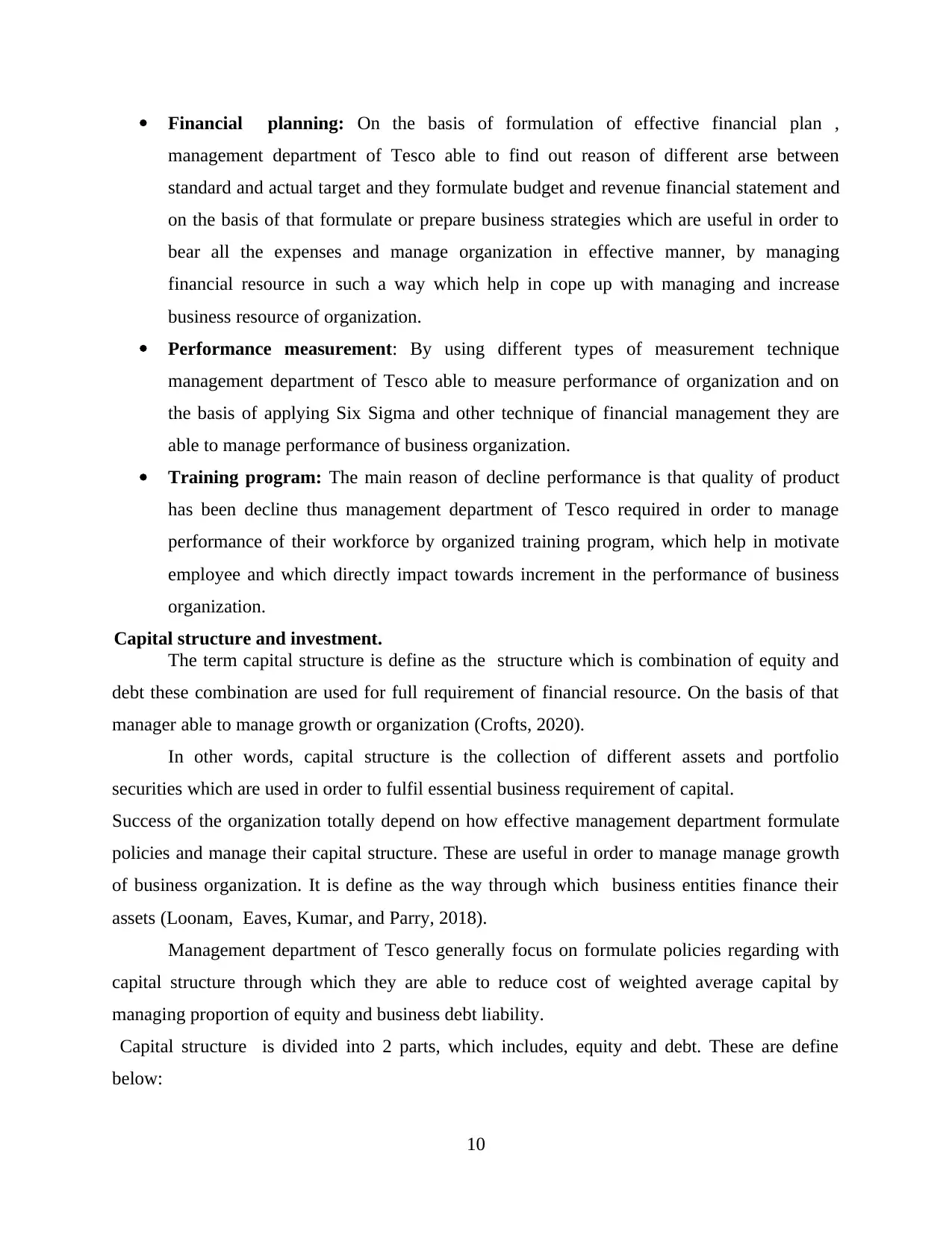
Financial planning: On the basis of formulation of effective financial plan ,
management department of Tesco able to find out reason of different arse between
standard and actual target and they formulate budget and revenue financial statement and
on the basis of that formulate or prepare business strategies which are useful in order to
bear all the expenses and manage organization in effective manner, by managing
financial resource in such a way which help in cope up with managing and increase
business resource of organization.
Performance measurement: By using different types of measurement technique
management department of Tesco able to measure performance of organization and on
the basis of applying Six Sigma and other technique of financial management they are
able to manage performance of business organization.
Training program: The main reason of decline performance is that quality of product
has been decline thus management department of Tesco required in order to manage
performance of their workforce by organized training program, which help in motivate
employee and which directly impact towards increment in the performance of business
organization.
Capital structure and investment.
The term capital structure is define as the structure which is combination of equity and
debt these combination are used for full requirement of financial resource. On the basis of that
manager able to manage growth or organization (Crofts, 2020).
In other words, capital structure is the collection of different assets and portfolio
securities which are used in order to fulfil essential business requirement of capital.
Success of the organization totally depend on how effective management department formulate
policies and manage their capital structure. These are useful in order to manage manage growth
of business organization. It is define as the way through which business entities finance their
assets (Loonam, Eaves, Kumar, and Parry, 2018).
Management department of Tesco generally focus on formulate policies regarding with
capital structure through which they are able to reduce cost of weighted average capital by
managing proportion of equity and business debt liability.
Capital structure is divided into 2 parts, which includes, equity and debt. These are define
below:
10
management department of Tesco able to find out reason of different arse between
standard and actual target and they formulate budget and revenue financial statement and
on the basis of that formulate or prepare business strategies which are useful in order to
bear all the expenses and manage organization in effective manner, by managing
financial resource in such a way which help in cope up with managing and increase
business resource of organization.
Performance measurement: By using different types of measurement technique
management department of Tesco able to measure performance of organization and on
the basis of applying Six Sigma and other technique of financial management they are
able to manage performance of business organization.
Training program: The main reason of decline performance is that quality of product
has been decline thus management department of Tesco required in order to manage
performance of their workforce by organized training program, which help in motivate
employee and which directly impact towards increment in the performance of business
organization.
Capital structure and investment.
The term capital structure is define as the structure which is combination of equity and
debt these combination are used for full requirement of financial resource. On the basis of that
manager able to manage growth or organization (Crofts, 2020).
In other words, capital structure is the collection of different assets and portfolio
securities which are used in order to fulfil essential business requirement of capital.
Success of the organization totally depend on how effective management department formulate
policies and manage their capital structure. These are useful in order to manage manage growth
of business organization. It is define as the way through which business entities finance their
assets (Loonam, Eaves, Kumar, and Parry, 2018).
Management department of Tesco generally focus on formulate policies regarding with
capital structure through which they are able to reduce cost of weighted average capital by
managing proportion of equity and business debt liability.
Capital structure is divided into 2 parts, which includes, equity and debt. These are define
below:
10

Equity capital: It is define as per the part of capital which is related with the real owner
of the organization,. It is define as the part which is owned from organizations shareholders. It is
further classified into 2 categories:
Retain earning: It is define as that part of ca[capital which is organized or generate by
profit. Retain earning is the part of profit which organization kept for their further business
activities or in case of contingency. This profit is consider as retain earning which provide
strengthen to business organization.
Contributed capital: It is define as that part of capital which owner or shareholders of
the organization is contributed or invested for business organization. It includes equity as well as
preference share capital.
Equity shareholder capital : it is the finance or share which help in run organization,
equity shareholders are consider or know as the real shareholder of the organization and they
help in run organization. However they are not entitled in order to get prefer right of dividend.
Preferences shareholder: These are consider as the prefer shareholder of the
organization. And when dividend are distributed they have first right to take benefits of getting
dividend. However they don't have right to particular and give vote during the time of business
meeting.
Debt capital: It is define as borrowed business capital which organization used to prefer
in order to spread their market share and fulfil financial needs of organization by taking loan or
securities from market. There are different types of debt capital which are define below:
Long term bonds: Theses types of bod are includes those securities on which fixed
amount of interest are required to paid by organization within given time period. As well as they
are consider as safest bond of security and on the basis of that manager able to raise their
financial capital. These are generally issue to public for longer time period. Following are the
item of long term debts:
Bond: These are issued by organization and they have fixed time of maturity.
Individual notes payable: These types of instrument are issued by personal or individual
investors (McMichael, 2020).
Lease obligation contract: Organization took lease for their operations for more then
of years , thus it is included in long term debt.
11
of the organization,. It is define as the part which is owned from organizations shareholders. It is
further classified into 2 categories:
Retain earning: It is define as that part of ca[capital which is organized or generate by
profit. Retain earning is the part of profit which organization kept for their further business
activities or in case of contingency. This profit is consider as retain earning which provide
strengthen to business organization.
Contributed capital: It is define as that part of capital which owner or shareholders of
the organization is contributed or invested for business organization. It includes equity as well as
preference share capital.
Equity shareholder capital : it is the finance or share which help in run organization,
equity shareholders are consider or know as the real shareholder of the organization and they
help in run organization. However they are not entitled in order to get prefer right of dividend.
Preferences shareholder: These are consider as the prefer shareholder of the
organization. And when dividend are distributed they have first right to take benefits of getting
dividend. However they don't have right to particular and give vote during the time of business
meeting.
Debt capital: It is define as borrowed business capital which organization used to prefer
in order to spread their market share and fulfil financial needs of organization by taking loan or
securities from market. There are different types of debt capital which are define below:
Long term bonds: Theses types of bod are includes those securities on which fixed
amount of interest are required to paid by organization within given time period. As well as they
are consider as safest bond of security and on the basis of that manager able to raise their
financial capital. These are generally issue to public for longer time period. Following are the
item of long term debts:
Bond: These are issued by organization and they have fixed time of maturity.
Individual notes payable: These types of instrument are issued by personal or individual
investors (McMichael, 2020).
Lease obligation contract: Organization took lease for their operations for more then
of years , thus it is included in long term debt.
11
⊘ This is a preview!⊘
Do you want full access?
Subscribe today to unlock all pages.

Trusted by 1+ million students worldwide
1 out of 15
Related Documents
Your All-in-One AI-Powered Toolkit for Academic Success.
+13062052269
info@desklib.com
Available 24*7 on WhatsApp / Email
![[object Object]](/_next/static/media/star-bottom.7253800d.svg)
Unlock your academic potential
Copyright © 2020–2025 A2Z Services. All Rights Reserved. Developed and managed by ZUCOL.





